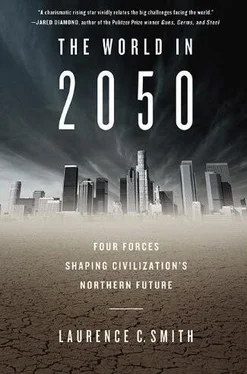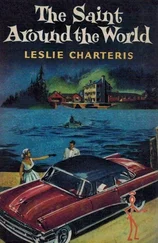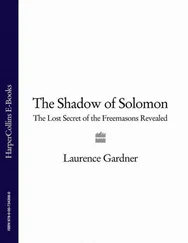Globalization kills economies too. After years of slow bleeding, my wife’s hometown in Michigan crashed when Delphi, a major supplier of automotive parts to General Motors Corporation, went bankrupt. Also, globalization’s spread is very uneven: The world is not so much “flat” as it is lumpy. Some countries, like Singapore and Canada, are integrating broadly and rapidly whereas others, like Myanmar and North Korea, are isolated backwaters.
Taking the long view, the world appears to be in the early phase of an economic transformation to something bigger and more integrated than anything ever seen before. It is more far-reaching and sophisticated than any previous alliance in human history. We will all be potential rivals, but also all potential friends. Alongside the demise of entire sectors will be new markets, new trade, and new partnerships. Gone are the days when General Motors could import rubber and steel and export automobiles. The design, raw materials, components, assembly, and marketing of today’s cars might come from fifty different countries around the world.
But what unleashed this new era of global integration upon us? Was it the blazing speed and easy reach of the Internet—or something deeper? I only noticed it in 1998, but might this phenomenon be older than we think?
Like rising world population and natural resource demand, the present global integration lifted off in the middle of the twentieth century. But unlike the first two, it happened deliberately. It all began with a big conference in the Mount Washington Resort near Bretton Woods, New Hampshire, in July 1944. Over seven hundred delegates from forty-four countries—including Britain’s John Maynard Keynes (whose ideas later found new life in the wake of the 2008 global credit meltdown)—were in attendance.
World War II was drawing to a close. Governments were turning their attention to their shattered economies and how to rebuild them after two catastrophic wars, a global depression, a long escalation of protectionist tariffs, and some crazy currency devaluations. Everyone at the conference wanted to figure out how to stabilize currencies, get loans to war-ravaged countries for rebuilding, and get international trade moving again.
The outcome of this conference was something called the Bretton Woods Agreement. Among other things, it stabilized international currencies by pegging them to the value of gold (which lasted until 1971, when President Richard Nixon dropped the U.S. dollar from the gold standard). But its most persistent legacy was the birth of three new international institutions: the International Monetary Fund (IMF) to administer a new monetary system; the International Bank for Reconstruction and Development (IBRD) to provide loans—today, the World Bank; and the General Agreement on Tariffs and Trade (GATT) to fashion and enforce trade agreements—today, the World Trade Organization (WTO). These three institutions guided much of the global reconstruction effort after the war; and during the 1950s their purpose expanded to giving loans to developing countries to help them industrialize. Today these three powerful institutions—the IMF, World Bank, and WTO—are the prime actors making and enforcing the rules of our global economy.
Up until the demise of the Bretton Woods monetary regulatory system in the early 1970s, it presided for three decades over what some have called the “golden age of controlled capitalism.” 29But by the 1980s, “controlled capitalism” had fallen to a revolution of “neoliberalism”—the deregulation and elimination of tariffs and other controls on international trade and capital flows. The neoliberalism movement was championed by British prime minister Margaret Thatcher and U.S. president Ronald Reagan, but was rooted in the ideas of Adam Smith.
Throughout the 1980s and 1990s the IMF, WTO, and World Bank aggressively pursued agendas of liberalizing (deregulating) trade markets around the world, vigorously urged on by the United States. 30A common tactic was to require developing countries to accept neoliberal reforms to qualify for IMF or World Bank loans. This practice was exemplified by the “Washington Consensus,” a controversial list of hard-nosed reforms including trade deregulation, opening to direct foreign investment, and privatization of state enterprises. 31
In the United States, presidents from both political parties also worked to dismantle international trade barriers. Of particular importance to this book was the North American Free Trade Agreement (NAFTA), proposed in 1991 by President George Herbert Walker Bush to remove trade barriers between the United States, Mexico, and Canada. Two years later, President Bill Clinton made NAFTA the cornerstone of his legacy. In his speech at the signing ceremony Clinton pressed the need “to create a new world economy,” with former presidents Bush, Jimmy Carter, and Gerald Ford nodding in attendance. Clinton’s successor also agreed: Fifteen years later, citing a near-quintupling of U.S. free-trade agreements under his watch, outgoing president George W. Bush stated that global trade expansion had been one of the “highest priorities of his administration.” 32
Notice that the origins of today’s great global integration are at odds with one of its most widely promulgated myths: that globalization has emerged organically, born from fast Internet technology and the “invisible hand” of free markets. In truth, this global force owes its existence to a long history of entirely purposeful policy decisions, championed especially by the United States and Britain, dating to the waning days of World War II. Many who write about globalization see it as exploding suddenly in the 1970s or 1980s, thus missing the institutional groundwork laid first under Bretton Woods, pressed upon the developing world by its daughter institutions the IMF, WTO, and World Bank, and subsequently advanced by U.S. presidential administrations of both political parties ever since. Its foundations are now codified into decades of historical precedent and a plethora of free-trade treaties. They are engrained in generations of politicians and business CEOs, and were reaffirmed even during the turmoil of the 2008-09 global financial crisis. 33This megatrend has roots going back more than sixty years and is now a deep, powerful global force already shaping the twenty-first century economy.

The fourth global force is climate change. Quite simply, it is observed fact that human industrial activity is changing the chemical composition of the atmosphere such that its overall temperature must, on average, heat up.
The power of greenhouse gases is simply beyond dispute. Their existence was deduced in the 1820s by the French mathematician Joseph Fourier, who noticed that the Earth is far warmer than it ought to be, given its distance from the Sun. Without greenhouse gases our planet would be an icebox, like the Moon and Mars, with temperatures some 60° Fahrenheit colder than today. 34Their magic comes from letting solar radiation easily in but not easily out, roughly analogous to how a closed-up car becomes hotter inside than out from sunlight passing through the window glass. 35
The basic physics of this was worked out in the 1890s by the Swedish chemist Svante Arrhenius. 36Like glass, greenhouse gases are transparent to short-wavelength sunlight, allowing it to pass unimpeded through the atmosphere to warm the Earth’s surface (unless blocked by a cloud). But they are opaque to the (invisible) long-wavelength infrared radiation returned from the warmed Earth back to space, instead absorbing it and thus becoming infrared radiators themselves.
Arrhenius was trying to solve the puzzle of ice ages, so was initially interested in global cooling, not warming, but his calculations worked easily well in either direction. He later wondered if humans, by adding carbon dioxide to the air through fossil-fuel burning, could also influence the planet’s climate. He ran the numbers and found that they certainly could, and substantially, too, if the gas’s concentration was raised high enough. His initial estimate of +5°C warming for a doubling of atmospheric CO 2, calculated by hand, was remarkably close to the ones generated by far more sophisticated computer models running today. But Arrhenius didn’t think much of this at the time, because he couldn’t imagine humans ever releasing that much carbon dioxide. For humans to double the atmosphere’s CO 2, he reasoned, would take at least three thousand years . 37
Читать дальше













